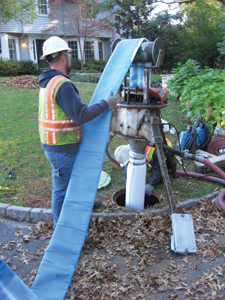Trenchless Manhole Rehabilitation in Bloomington, Ind.
 Finding a trenchless rehabilitation solution for wastewater systems can be complicated because of the variety of solutions available to address diverse problems. Effective system rehabilitation cannot be limited to either pipe rehabilitation or manhole rehabilitation.
Finding a trenchless rehabilitation solution for wastewater systems can be complicated because of the variety of solutions available to address diverse problems. Effective system rehabilitation cannot be limited to either pipe rehabilitation or manhole rehabilitation.
Complete wastewater system rehabilitation is possible by using a combination of technologies to renew all types of assets and well-coordinated project planning. The use of cured-in-place pipe (CIPP) technologies and multi-layered, polymeric coatings renews sanitary and storm sewers, manholes and other wastewater structures. It also saves time and money to provide a complete solution.
According to Troy Reed of SpectraTech, “There are several benefits of complete wastewater system rehabilitation. Inflow and infiltration is eliminated, reducing the amount of water being treated at the treatment plant and resulting in significant cost-savings.”
Pipeline Solutions
Since its first installation in 1971, CIPP has become one of the most widely used forms of trenchless pipeline rehabilitation. CIPP is a non-disruptive solution for sanitary and storm sewer pipelines that spans leaks and holes, fills gaps and helps cut down on leakage and infiltration. These benefits make it an excellent part of an sanitary sewer overflows/combined sewer overflows (SSO/CSO) program.
A resin-saturated CIPP tube is inserted using either an inversion or pull-in process with pressurized water or steam. The CIPP is then cured using hot water or steam, forming a fully functional pipe-within-a-pipe.
In addition, due to its non-disruptive nature and quick installation, it is generally considered a “green” technology. Insituform’s air-inversion steam-cure (AISC), which uses air to invert the CIPP tube and then steam to cure the resin, can reduce the amount of water used during projects by nearly 95 percent.
While CIPP technology is a suitable solution for pipe collection systems, rehabilitation of wastewater structures such as manholes, headworks, wet wells and grit chambers requires other specialized solutions.
Manhole Rehabilitation Solutions
Polymeric coatings are installed using a multi-layered spray-on method consisting of an initial layer of polyurea, a resurfacing layer of polyurethane foam and a final layer of polyurea to address the problems of corrosion, fatigue and infiltration. This three-step process can be completed in as little as one hour and is a suitable component of a project using the CIPP method for pipe rehabilitation.
In Bloomington, Ind., restoring the structural integrity of an aged sanitary sewer collection system in a predominantly residential area was necessary due to inflow-and-infiltration. Insituform CIPP was used to rehabilitate 18,000 ft of 8-in. vitrified clay pipe (VCP), 1,800 ft of 10-in. VCP and 170 ft of 12-in. VCP. Because of collapse, several point repairs in the pipe were also necessary.
In addition, a multi-layered polymeric system was used to restore 106 manholes. A comprehensive solution that addressed all causes of infiltration was the logical choice for Bloomington.
Reed said, “Lining sewers and manholes, rather than doing a total dig-and-replace, keeps costs to a minimum because it eliminates the need for securing easements, doing road repair and restoration of sidewalks, yards, etc. Lining takes significantly less time than other methods, minimizing downtime and road closings.”
Jim Johnson of Infrastructure Contractors praised Bloomington officials: “The City of Bloomington has taken a very proactive approach in dealing with their waste collection system. In jointly attacking the pipe and manhole issues simultaneously, they managed to take advantage of one general contractor coordinating all facets of the rehabilitation process.”
The rehabilitation resulted in a decrease of inflow-and-infiltration, the elimination of nine SSO locations and increased capacity to the wastewater treatment facility.
Reed added, “The SpectraShield product has a 10-year warranty and a 100-year life design. The manholes lined with the SpectraShield liner are effectively permanent repairs.”
The results suggest that the sewer system rehabilitation exceeded the 15 percent reduction goal for rainfall-derived infiltration/inflow (RDII) by volume. The RDII peak flow rates were reduced by nearly 15 percent.
Johnson concluded the City would likely reap the benefits of a complete solution for years to come. “They have realized the importance of using quality lining systems and should be commended for their foresight. Their long-term cost savings should be significant,” he said.
This article was submitted by Insituform Technologies and edited by the TT staff.
![]()
